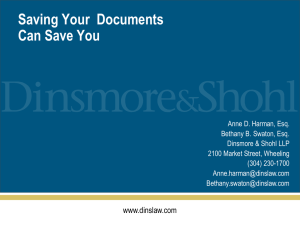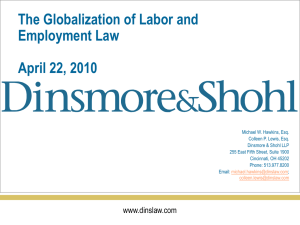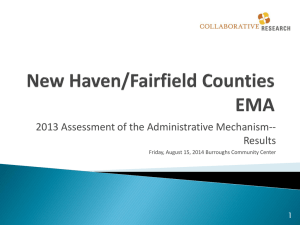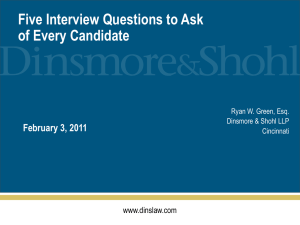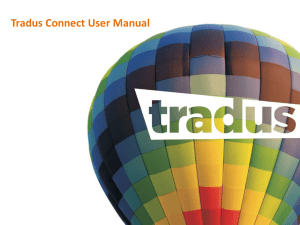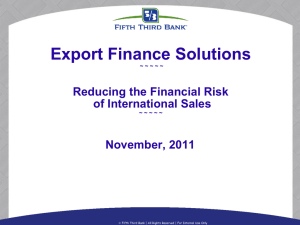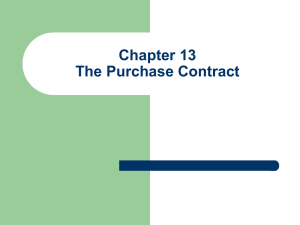The New Incoterms 2010 Workshop, Charleston, WV
advertisement
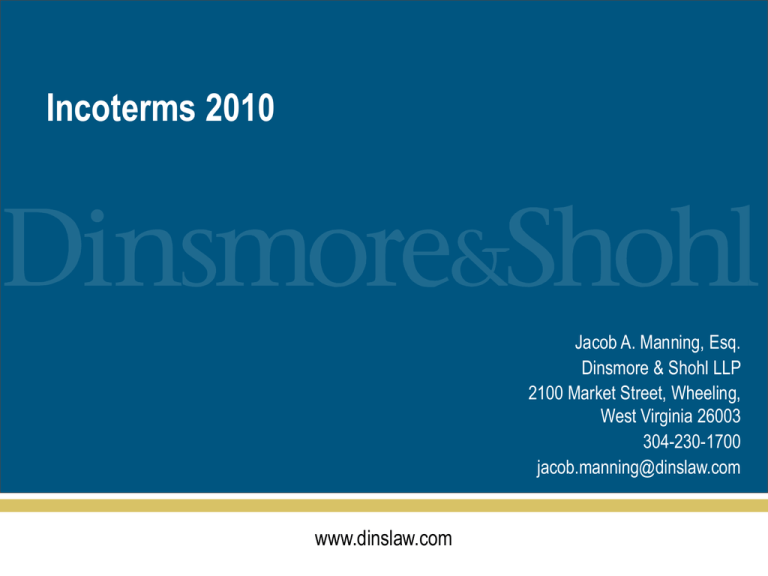
Incoterms 2010 Jacob A. Manning, Esq. Dinsmore & Shohl LLP 2100 Market Street, Wheeling, West Virginia 26003 304-230-1700 jacob.manning@dinslaw.com www.dinslaw.com Background n International Commercial Terms – First published in 1936 by International Chamber of Commerce – Revised 6 times before 2010 – Current revision (“Incoterms 2010”) to become effective January 2011 © 2010 Dinsmore & Shohl LLP | www.dinslaw.com Purpose n Simplify some terms of an international sales agreement n What do Incoterms not do? – Take the place of a sales agreement or terms and conditions – Supply all terms for an international sale n Not for service contracts n Do not determine transfer of title n Do not determine breach of contract or remedies n Do not protect parties from their own risk of loss n Do not cover goods before or after delivery © 2010 Dinsmore & Shohl LLP | www.dinslaw.com Purpose n Apply to contract of sale – Not contract of carriage – Not contract of insurance – Not documents related to financing – Even if those documents and the Incoterm Rule chosen have some implications for one another © 2010 Dinsmore & Shohl LLP | www.dinslaw.com Purpose n Terms covered by Incoterms – Warehousing – Packing and loading – Inland freight – Terminal charges – Freight forwarder’s fees – Ocean/air freight – Duty, taxes, & customs clearance – Delivery – Security Clearances (new to 2010) © 2010 Dinsmore & Shohl LLP | www.dinslaw.com 2010 Changes n Two new rules: – – DAT (delivered at terminal) n Delivered at a named place, at buyer’s disposal, unloaded n Replaces DEQ DAP (delivered at place) n Delivered at a named place, at buyer’s disposal, not unloaded n Replaces DAF, DES, DDU © 2010 Dinsmore & Shohl LLP | www.dinslaw.com 2010 Changes n 2 Groups of Incoterms Rules n Rules for Any Mode of Transport – n EXW, FCA, CPT, CIP, DAT, DAP, DDP Rules for Sea and Inland Waterway Transport – FAS, FOB, CFR, CIF © 2010 Dinsmore & Shohl LLP | www.dinslaw.com 2010 Changes n Domestic-User-Friendly – Now state that Rules can be used domestically – Obligation to comply with export /import formalities is “where applicable” – Coincided with declining use of UCC terms – May be used within the EU © 2010 Dinsmore & Shohl LLP | www.dinslaw.com 2010 Changes n n Guidance Notes – Explain fundamentals, usage, risk, costs, etc. – Review and use them Electronic Communication – n Electronic means of communication now given same effect as paper as long as parties agree or where customary Security-Related Clearances – Rules now allocate responsibility for these © 2010 Dinsmore & Shohl LLP | www.dinslaw.com 2010 Changes n String Sales – n Rules now recognize that seller may fulfill its obligations by procuring goods that have been shipped Terminal Handling Charges – Now specifically allocated so that buyer is not charged twice (seller and terminal) © 2010 Dinsmore & Shohl LLP | www.dinslaw.com Transition to 2010 Rules n Existing contracts (even if performance continues into 2011) – n Contracts entered into before January 2011 – n Continue to apply 2000 edition Should specify which version will apply Contracts entered into beginning in January 2011 – 2010 will apply © 2010 Dinsmore & Shohl LLP | www.dinslaw.com Rules for any mode of transport n Ex Works (EXW) n Free Carrier (FCA) n Carriage Paid To (CPT) n Carriage and Insurance Paid To (CIP) n Delivered at Terminal (DAT) n Delivered at Place (DAP) n Delivered Duty Paid (DDP) © 2010 Dinsmore & Shohl LLP | www.dinslaw.com Ex Works n Ex Works – Seller delivers when it places the goods at the disposal of buyer at the seller’s premises or another named place (i.e. works, factory, warehouse, etc.). – Seller does not need to load the goods on any collecting vehicle, nor does it need to clear the goods for export, where such clearance is applicable. © 2010 Dinsmore & Shohl LLP | www.dinslaw.com Ex Works n n Fewest up front requirements for seller Example: “Ex works [factory] Wheeling, WV, U.S.A. (Incoterms 2010)” © 2010 Dinsmore & Shohl LLP | www.dinslaw.com Ex Works n Notes – Seller has no obligation to load goods, even if better-suited to do so – If seller does load goods, it does so at buyer’s expense and risk – Better-suited to domestic transport (no obligation that seller clear goods for export—only provide assistance if necessary at buyer’s expense and risk) – Buyer bears all risk of loss from time seller places goods at buyer’s disposal © 2010 Dinsmore & Shohl LLP | www.dinslaw.com FCA n Free Carrier – Seller delivers the goods to the carrier or another person nominated by the buyer at the seller’s premises or another named place. – The parties are well advised to specify as clearly as possible the point within the named place of delivery, as the risk passes to the buyer at that point. © 2010 Dinsmore & Shohl LLP | www.dinslaw.com FCA n Notes – Seller does clear goods for export; import formalities are buyer’s responsibility – Seller may contract for carriage at buyer’s expense and risk © 2010 Dinsmore & Shohl LLP | www.dinslaw.com FCA n Seller’s delivery options – If the named place is seller’s premises: seller must load goods onto buyer’s means of transport – If the named place is any other place: seller must place the goods at buyer’s (or his carrier’s disposal) on seller’s mode of transport (ready for unloading) © 2010 Dinsmore & Shohl LLP | www.dinslaw.com FCA n n Improvements over Ex Works – Seller clears goods for export – Can be used to require seller to load goods, when seller is in a better position to do so But… – Buyer may have little idea what delivery at seller’s factory means – Buyer has costs in addition to sales price that must calculated – Seller has no control over carrier, insurance, etc. © 2010 Dinsmore & Shohl LLP | www.dinslaw.com CPT n Carriage Paid To – Seller delivers the goods to the carrier or another person nominated by the seller at an agreed place (if any place is agreed between the parties) and the seller must contract for and pay the costs of carriage necessary to bring the goods to the named place of destination. © 2010 Dinsmore & Shohl LLP | www.dinslaw.com CPT n 2 points of importance – – Place of delivery of goods to carrier n Seller’s delivery obligation is complete n Risk of loss passes Place of destination n Seller contracts for and pays for carriage to the place of destination © 2010 Dinsmore & Shohl LLP | www.dinslaw.com CPT n An Example: – Contract says seller is to deliver goods to shipping warehouse in Charleston, WV. Terms of sale are “CPT buyer’s facility, 24 Waffle Place, #1, Singapore 048621 (Incoterms 2010).” – Delivery obligation is fulfilled when seller delivers to the shipping facility in Charleston. – Risk of loss passes at the moment the goods are handed over to the carrier in Charleston. – But seller pays for carriage to Singapore. © 2010 Dinsmore & Shohl LLP | www.dinslaw.com CPT n Notes – Seller clears goods for export and pays for transport through any country necessary to delivery – Seller has no obligation to pay for insurance but must provide buyer information to buy insurance at buyer’s risk and expense – Buyer obtains import licenses and carries out customs formalities – Seller pays for both loading and unloading if covered by contract of carriage © 2010 Dinsmore & Shohl LLP | www.dinslaw.com CIP n Carriage and Insurance Paid To – Seller delivers the goods to the carrier or another person nominated by the seller at an agreed place (if any such place is agreed between the parties); seller must contract for and pay the costs of carriage necessary to bring the goods to the named place of destination. © 2010 Dinsmore & Shohl LLP | www.dinslaw.com CIP n Notes – Like CPT but with the additional requirement that seller pay for insurance to the named destination – Insurance requirement is minimum cover (institute cargo clause c) in the amount of contract price plus 10% from point of delivery to point of destination – Buyer may pay for additional coverage (institute cargo clauses a or b); seller must provide the information necessary to allow buyer to do so © 2010 Dinsmore & Shohl LLP | www.dinslaw.com DAT n Delivered at Terminal – Seller delivers when the goods, once unloaded from the arriving means of transport, are placed at the disposal of the buyer at a named terminal at the named port or place of destination. – “Terminal” includes any place, whether covered or not, such as a quay, warehouse, container yard or road, rail or air cargo terminal. – The seller bears all risks involved in bringing the goods to and unloading them at the terminal at the named port or place of destination. © 2010 Dinsmore & Shohl LLP | www.dinslaw.com DAT n Notes – Seller’s obligation is fulfilled and risk of loss passes at same time: when the goods are unloaded at the arriving terminal and placed at buyer’s disposal – Can specify a point within the terminal at which time the obligation is complete – Seller clears goods for export but not for import – No requirement of insurance – If the intention is to carry seller’s obligation further into buyer’s country, use DAP or DDP © 2010 Dinsmore & Shohl LLP | www.dinslaw.com DAP n Delivered at Place – Seller delivers when the goods are placed at the disposal of the buyer on the arriving means of transport ready for unloading at the named place of destination. – The seller bears all risks involved in bringing the good to the named place. © 2010 Dinsmore & Shohl LLP | www.dinslaw.com DAP n Notes – Much like DAT, but with additional obligation by seller into country of delivery – Goods are placed at buyer’s disposal at named location ready for unloading; risk passes at that point – Seller clears goods for export but not import (use DDP if intent is to require seller to clear goods for import also). – No obligation on seller to purchase insurance © 2010 Dinsmore & Shohl LLP | www.dinslaw.com DDP n Delivered Duty Paid – Seller delivers the goods when the goods are placed at the disposal of the buyer, cleared for import on the arriving means of transport ready for unloading at the named place of destination. – The seller bears all the costs and risks involved in bringing the goods to the place of destination and has an obligation to clear the goods not only for export but also for import, to pay any duty for both export and import and to carry out all customs formalities. © 2010 Dinsmore & Shohl LLP | www.dinslaw.com DDP n Notes – Like DAP, but including seller’s obligation to clear goods for import—pay for any necessary licenses – Maximum obligation for seller – If seller is not well-suited to clear goods for import, DAP should be used – No obligation to pay for insurance © 2010 Dinsmore & Shohl LLP | www.dinslaw.com Rules for Sea and Inland Waterway Transport n Free Alongside Ship (FAS) n Free On Board (FOB) n Cost and Freight (CFR) n Cost Insurance and Freight (CIF) © 2010 Dinsmore & Shohl LLP | www.dinslaw.com FAS n Free Alongside Ship – Seller delivers when the goods are placed alongside the vessel (e.g., on a quay or a barge) nominated by the buyer at the named port of shipment. – The risk of loss of or damage to the goods passes when the goods are alongside the ship, the buyer bears all costs from the moment onwards. © 2010 Dinsmore & Shohl LLP | www.dinslaw.com FAS n Notes – Usage: “FAS Charleston, SC, USA (Incoterms 2010)” – Can be used in a string sale where seller procures goods already delivered for shipment – Seller is obligated to clear goods for export but not import – Seller has no obligation to pay for contracts of carriage or insurance but may contract for carriage and must assist buyer by providing necessary information for insurance © 2010 Dinsmore & Shohl LLP | www.dinslaw.com FAS n Notes – Not appropriate when goods in container and delivered to carrier at terminal; use FCA – Might want to define what it means to be “alongside” ship © 2010 Dinsmore & Shohl LLP | www.dinslaw.com FOB n Free on Board – Seller delivers the goods on board the vessel nominated by the buyer at the named port of shipment or procures the goods already so delivered. – The risk of loss of or damage to the goods passes when the goods are on board the vessel, and the buyer bears all costs from that moment onwards. © 2010 Dinsmore & Shohl LLP | www.dinslaw.com FOB n Notes – Notice change in 2010: “free on board” no longer means across the ship’s rail; now means on board the vessel – Another change in 2010: if requested by buyer or if it is commercial practice and buyer does not instruct otherwise, seller may contract for carriage at buyer’s risk and expense; seller may decline but must notify buyer promptly n Therefore, may want to exclude if that is the intent – Like FAS but goods must be placed on board – Usage: “FOB Charleston, SC, USA (Incoterms 2010)” © 2010 Dinsmore & Shohl LLP | www.dinslaw.com CFR n Cost and Freight – Seller delivers the goods on board the vessel or procures the goods already so delivered. – The risk of loss of or damage to the goods passes when the goods are on board the vessel. – The seller must contract for and pay the costs and freight necessary to bring the goods to the named port of destination. © 2010 Dinsmore & Shohl LLP | www.dinslaw.com CFR n 2 places of importance – Place of delivery of goods n n – Seller’s delivery obligation is fulfilled when goods are on board the vessel Risk of loss passes when the goods are on board the vessel Port of destination n Seller pays for carriage to port of destination © 2010 Dinsmore & Shohl LLP | www.dinslaw.com CFR n Examples: – Contract says: Seller is to deliver goods on board vessel at Port of Charleston, SC, USA. Terms of sale are: “CFR, Shanghai (Incoterms 2010).” n n – Seller’s delivery obligation is fulfilled when the goods are on board the vessel in South Carolina; risk of loss passes then also Seller must pay for shipment to Shanghai Contract says terms of sale are: “CFR, Shanghai (Incoterms 2010).” Silent as to port of shipment n n Seller’s delivery obligation is fulfilled when the goods are on board the vessel in the port selected by seller; risk of loss passes then also Seller must pay for shipment to Shanghai © 2010 Dinsmore & Shohl LLP | www.dinslaw.com CFR n Notes – Seller pays for unloading if the contract of carriage covers unloading – Seller clears goods for export but not import – Seller has no obligation to obtain insurance – If intent to ship in containers and delivery is to carrier other than vessel, use CPT © 2010 Dinsmore & Shohl LLP | www.dinslaw.com CIF n Cost Insurance and Freight – Seller delivers the goods on board the vessel or procures the goods already so delivered. – The risk of loss of damage to the goods passes when the goods are on board the vessel. – The seller must contract for and pay the costs and freight necessary to bring the goods to the named port of destination. © 2010 Dinsmore & Shohl LLP | www.dinslaw.com CIF n Notes – Like CFR but with additional obligation to procure insurance to port of destination – Insurance requirement is minimum cover (institute cargo clause c) in the amount of contract price plus 10% from point of delivery to point of destination – Seller clears goods for export but not import © 2010 Dinsmore & Shohl LLP | www.dinslaw.com Final Advice n n 2000 division of rules by seller’s obligation – E (Make goods available at own premises) – F (Deliver goods to a carrier appointed by buyer) – C (Contract for carriage without assuming risk of loss during shipment) – D (Bear all costs and risks needed to bring goods to place of destination) But remember rules are split by mode of transport © 2010 Dinsmore & Shohl LLP | www.dinslaw.com Final Advice n n Usage—use the phrase “Incoterms 2010” after the rule and named place – Clarifies that 2000 version does not apply – Ensures no confusion with UCC (esp. given new focus on domestic use) Usage—ensure you are naming the right location – EXW, FCA, FAS, FOB, DAT, DAP, DDU=place of delivery – CPT, CIP, CFR, CIF=place of desination © 2010 Dinsmore & Shohl LLP | www.dinslaw.com Final Advice n Use contract of sale or terms and conditions n Be careful modifying Incoterms Rules – If you do modify rules (not advised), ensure contract clarifies what you are modifying and what you are not © 2010 Dinsmore & Shohl LLP | www.dinslaw.com Jacob A. Manning, Esq. 304-230-1700 | jacob.manning@dinslaw.com www.dinslaw.com
